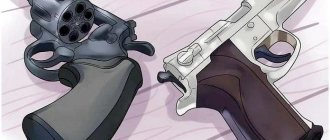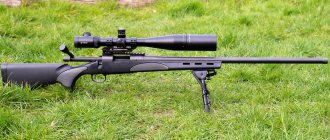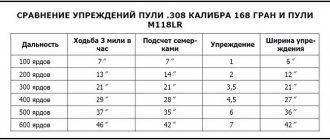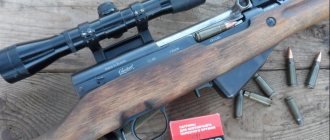“Who would have thought that I would become the World Champion! A girl from Uralmash,” writes Alena Karelina, a multiple world champion in practical carbine shooting, on VKontakte. Remembering her French victory at the next World Championship, the Honored (Honored!!!) Master of Sports, she, like a girl, is happy that she was not scared on the roller coaster in Disneyland Paris. This is truly a “girl from Uralmash”. It is known about women from Russia: they will stop a galloping horse and enter a burning hut. A Russian woman with a carbine is natural and organic. At the same time, she is stylish, graceful and attractive.
Shooter's Code
Practical shooting with a carbine cannot be absolutely safe. But safety is the main priority in practical shooting. This is what all competition practice, all regulations, all the requirements of this sport are aimed at. Security must always be ensured, regardless of any emerging circumstances. The set of main principles for ensuring safety in practical shooting is called the “Shooter Code”. Sometimes even the name “Shooter’s Prayer” appears. There are four points in this code.
I believe that my weapon is always loaded.
This is more likely not a rule “how to behave”, but a mental attitude. Weapons are dangerous and sometimes unpredictable. It is known that even an unloaded gun hanging on the wall can fire one day. When dealing with weapons, you should be prepared for such a turn of events. You never know. So a real shooter assumes that his weapon is always loaded.
Athletes perform in protective glasses and headphones
I point the gun only where I'm going to shoot.
Actually, a good shooter only picks up a weapon when he is about to shoot. Usually the weapon is in a holster or in a pyramid. But, if the weapon in your hands is not for shooting, then its barrel is pointed upward. The first principle is to remember that the weapon is always loaded.
I only put my finger on the trigger when the target is in sight.
That is, the shooter inserts the index finger into the trigger guard immediately before firing. Before this, the straightened index finger lies on the stock of the carbine. The rule always applies whether the shooter is armed with a pistol or rifle.
I always check what is in front of the target and behind the target.
This rule should not be interpreted literally. Before the second shot in a series, especially at long distances, none of the shooters checks whether this safety condition has been met. But before starting a series of shots, you should make sure that all conditions have been created so that there are no strangers or other athletes either in front of the target or behind the paper target. You should be aware that people may appear there and take care of their safety.
Getting ready to fire
92. To prepare for shooting, a command is given, approximately: “Shooter so and so, the place for shooting is there - for battle.”
. But for this command, the shooter takes the place for shooting, applying himself to the terrain, and is prepared for shooting.
In a battle when there is a surprise attack by the enemy, the shooter, if he has not been given a command, prepares to fire on his own.
During training sessions, the command to prepare to fire can be given separately, for example: “To the firing line, step - march”
and then -
“Charge”
. If necessary, the firing position is indicated before the “Load” command.
93. If the carbine is in the “belt”, “behind the back” or “shoulder” position before readying, remove the carbine and take it in the “at the foot” position (the butt may be slightly raised).
94. To shoot while standing you need:
turn half a turn to the right in relation to the direction towards the target and, without placing your left leg, set it to the left approximately shoulder-width apart, as convenient for the shooter, while distributing the weight of the body evenly on both legs; at the same time, with your right hand, vigorously move the carbine with the muzzle forward in the direction of the target and grab it with your left hand at gunpoint, pressing the elbow of your left hand to your side; move your right hand to the bolt handle (Fig. 44, a), load the carbine; after loading, grab the neck of the stock with your right hand and move the carbine slightly forward (Fig. 44, b).
95. To shoot prone you need:
turn half a turn to the right, at the same time put your right leg forward half a step and, tilting the carbine with the muzzle towards the target, quickly lower yourself onto your left knee, then, leaning on your left hand, lie in a new direction on your left side and elbow of your left hand, place the carbine on the palm of your left hand (at gunpoint) and lower the butt to the ground; load the carabiner (Fig. 45, a).
| A | b |
Rice. 44. Preparation for shooting while standing:
a - before loading; b - after loading
After loading the carbine, lie flat, legs slightly spread to the sides, toes outward, clasp the neck of the stock with your right hand and point the carbine towards the target (Fig. 45, b).
96. To shoot from the knee you need:
energetically move the carbine with the muzzle towards the target and pick it up with your left hand at gunpoint; simultaneously move your right leg back and slightly to the left, quickly drop to your knees and sit on your heel; keep the shin of the left leg as straight as possible; the thighs of the legs should form an angle close to a straight line; place your left hand on the thigh of your left leg, and move your right hand to the bolt handle (Fig. 46, a); load the carabiner; after loading, grab the neck of the stock with your right hand and move the carbine slightly forward (Fig. 46, b).
| a |
| b |
Rice. 45. Preparation for prone shooting:
a - when loading; b - after loading
97. To load the carbine you need:
- open the bolt (Fig. 47), for which, while holding the carbine at gunpoint with your left hand, pull the bolt back with your right hand so that it is held by stopping the bolt; it is also allowed to retract the shutter with the thumb and forefinger or thumb;
- put the safety on (if the carabiner was not on the safety), for which turn the safety flag up until it stops;
- insert the clip into the vertical grooves of the bolt stem and, placing the thumb of your right hand on the cartridge at the clip (Fig. 48), send the cartridges to the magazine, then remove the clip (put it in the cartridge bag);
- close the shutter by pulling it back as far as it will go with your right hand and sharply releasing it.
| A | b |
Rice. 46. Preparation for shooting from the knee:
a - before loading; b - after loading
| Rice. 47. Opening the shutter | Rice. 48. Loading a carbine |
98. If the clip was not loaded with cartridges, then it must be loaded before loading the carbine.
To equip a clip with cartridges, you need to take it in your left hand and place the cartridge with the bottom of the cartridge case on the end of the cartridge spring, press the spring against the cartridge and feed the cartridge so that the groove of the cartridge case fits into the longitudinal grooves of the cartridge, then push the cartridge until the bottom of the cartridge case stops against the stopper of the opposite end of the cage spring. This way all ten cartridges are inserted into the clip.
Loading a carbine without a clip is done by inserting cartridges into the magazine, one at a time, from the top through the receiver window.
Weapon Types
There are three types of weapons: pistol, shotgun and carbine.
Pistol and shotgun
The most popular type of practical shooting sport in the world is pistol shooting. A pistol is an ideal means of self-defense. The pistol is not usable at long range, but it is indispensable in close combat.
Shooting from a smoothbore gun is a “hunting” type of practical shooting. Whether the hunter is facing a bear, an elk, or the hunter is just aiming at a wild boar: good practical shooting skills are a very important thing.
Carbine
There is an opinion that practical shooting was invented to provide an objective basis for comparing the combat power of special army units. But then it is not clear why the weapons for practical shooting were not machine guns (the basic type of small arms), but three other, more exotic types of weapons. Participants in practical shooting competitions choose from three options: a pistol, a smoothbore shotgun, and a rifled carbine. In the Russian army, the carbine remained in service only with the Kremlin parade regiment, which serves parades on Red Square and honor guards.
Open class carbine with automatic loading
And practical shooting athletes insist that it is more powerful and longer-range than a pistol or even a shotgun.
Carbines are divided into 4 classes:
- Standard. Manual reloading;
- Standard. Self-loading;
- Open. Manual reloading;
- Open. Self-loading.
The difference between them is determined by the set of legally permitted modifications. In class 1, even light tuning is prohibited. Only commercially produced parts may be used. It's like racing Zhiguli cars of the same model, just rolled off the same assembly line. Perhaps this is the cleanest, from a sporting point of view, option. It all depends on the skill of the shooter. In this case, it is impossible to obtain any benefits due to modernization, including non-standard authoring. Success is determined by a person, his natural abilities and hard training. In class 4, technical competition is possible. It's like Formula 1 in motorsport. Each team has its own, essentially original, author's car. And it is often not the best driver who wins, but the best car.
The rules for shooting a carbine for open standards with both manual and automatic reloading give great freedom. They even allow you to use a parapet for shooting, shoot with a tripod, or use a bipod.
Training in practical shooting from a carbine
Men and women are allowed to study starting from the age of fourteen. In order to apply to join the Russian Practical Shooting Federation, you need to take a course consisting of just a few lessons. Practical shooting involves, first of all, working in a “standing” position. Often, beginners begin to be trained immediately in a “standing” position. Sometimes they start in the “lying” position. Moreover, shooting from a rest position, from a bag of sawdust. And only gradually do they master the “standing” position. It is more difficult to aim and shoot while standing, but in competitions they use standing positions. Moreover, standing, in relation to practical shooting, they say conditionally, or more precisely it would be - not standing, but almost running.
A carbine is a type of rifle. The shooting technique is similar. Shooting training is the same as for a rifle. First, the student shoots at a shooting range, and long-range shooting is studied in the field. It’s good if the student first shot from rests, then from hand.
Accurate shooting with a carbine is a skill. The cadets quickly master the basic technique of using rifles during training. A rifle is a simple thing, but you can study a rifle-carbine endlessly, achieving ever faster and more accurate shooting.
Ski shooting techniques
116. Shooting from skis can be carried out from a carbine from a place (lying, kneeling, standing) and on the move.
Rice. 64. Prone ski shooting
117. For shooting from skis while lying down
take the carabiner in your right hand, the poles in your left, leaving the heels of the skis in place, and spread the toes of the skis to the sides. Leaning on sticks, kneel down. Lie down, put the fastened sticks under your elbows and hold the carbine in the same way as when shooting prone without skis (Fig. 64).
118. For shooting from skis from the knee
place the poles on the left side, turn the right ski with the toe to the right, lower your right knee onto the right ski and take the position as for shooting from the knee without skis (Fig. 65).
Rice. 65. Shooting from skis from the knee
119. For shooting from skis while standing
place the poles on the left side, slightly turn the right ski with the toe to the right and take the position as for shooting while standing without skis (Fig. 66).
For stability when shooting from skis while standing, you can use sticks as a support, for which you fasten the sticks with loops and place the carbine with the fore-end on the loops (Fig. 67).
| Rice. 66. Shooting from skis while standing | Rice. 67. Shooting from skis while standing and using sticks as a support |
| Rice. 68. Shooting from skis on the move | Rice. 69. Shooting from skis in motion with fastened sticks |
120. For shooting from skis on the move
put the loops of the sticks on your hands, with your right hand press the butt to your right side, with your left hand, holding the carbine by the fore-end, point it at the target, without stopping the movement, open fire (Fig. 68). Shooting can be carried out with the loops of both sticks fastened together on the right or left hand (Fig. 69).
Practical rifle shooting competition
There are twelve types of practical carbine shooting competitions.
Shooting duel is a special type of competition
Shooters compete armed with standard or open class carbines, with manual or automatic reloading. There are individual and team competitions; a team consists of four people. Competitions in the format of duel individual fights have a unique tournament grid. At competitions, each participant sequentially performs several so-called “exercises,” that is, a series of shots moving from a shooting point to another shooting point. Range to targets: 30% closer than 60 m, 50% - 60-150 m and 20% - 150-300 m. When shooting at a long distance, judges use an optical tube using a tripod. The tripod is for convenience.
The competition takes into account accuracy, speed and power.
Russia is traditionally included among the leading countries in rifle shooting. There are always many great athletes performing at the Russian Championships. The competitions are spectacular. You can watch it on YouTube if you want.
F-class
F-class is target shooting for points at distances of 300, 500, 600, 800, 900, 1000 yards (274.3, 457.2, 548.6, 731.5, 822.9, 914.4 meters). Shooting is done while lying down. Competitors can use any caliber rifle up to and including 338LM, as well as any scopes, front and rear rests, and bipods.
The size of the scoring zone on the target is only 12.8 cm. In the F-class it is prohibited to use various types of muzzle brake compensators (DTC), ballistic calculators and weather stations.
How the competition takes place:
Shooters fire two sighting shots and 15-20 scoring shots at a target for a limited time. Hitting the center of the target is worth 5 points, hitting the outer circle is worth 2 points. The winner is determined by the number of points scored. Competitions are held in both individual and team formats. High results in the F-class can only be achieved by preparing a shooting system (rifle, scope, cartridge, shooter), which ensures shooting accuracy of at least 0.5 MOA, as well as having good wind reading skills.
Exercise “Moose Hunting”
The carbine is different from the carbine. Shooting from a hunting weapon has its own characteristics. One of the mandatory exercises in practical shooting with a carbine is hitting a target moving perpendicular to the aiming line. The exercise simulates shooting from hunting rifles. As provided by the rules, they shoot at the elk. Such rifle hunting for elk. The series consists of two shots: the first is fired when the elk is moving from right to left, and the second is when the elk is moving from left to right. The moose moves at a speed of about 5 meters per second and travels along a front of 25 m, that is, the target is in the shooter’s field of view for about 5 seconds. The target is an image consisting of two halves: on the left, the moose's head looks to the left, and on the right, to the right. It turns out to be a kind of “push-pull” moose, which you need to hit twice with a hunting carbine. Hunting doublet.
Practical shooting is carried out from a standing position
The interval between the forward and reverse passage of the elk target is 5 seconds. This is similar to an Olympic shooting event and is reminiscent of shotgun shooting for hog hunting in the case of a "running hog" target.
World Carbine Championship
This was the very first World Practical Carbine Shooting Championship (WC). One of the tournaments of the highest fifth category, it took place in a unique place - in the shooting complex of the Patriot Park of the Russian Ministry of Defense near Mytishchi. The unique capabilities of this complex served as the basis for choosing Russia as the host for the World Cup. The firing range of carbines on this complex can be up to 1000 meters.
The championship brought together more than a thousand participants, the championship was shown by leading TV channels. Russia won the unofficial team competition: we shoot well.
Bank of Russia coin for the World Cup in Moscow
The championship was even celebrated by the Central Bank of the Russian Federation. In honor of the championship, a commemorative coin “25 rubles 2022 carbine shooting championship” was issued. Someone will say - a coin is like a coin. And this is not an ordinary coin! This coin does not have a large number “25”; on the coin it is written in a line how many rubles it contains. The coin is valued by collectors; in the fall of 2022 it could be bought on the market for 2,000 rubles.
Our teams won the Moscow World Championship. Both - male and female.









